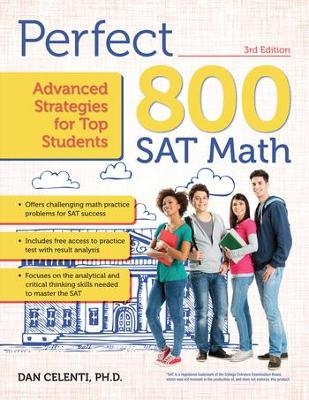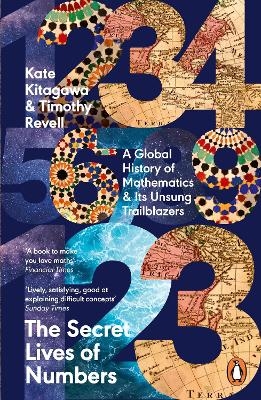
Perfect 800
Prufrock Press (Verlag)
978-1-61821-622-9 (ISBN)
- Titel erscheint in neuer Auflage
- Artikel merken
The previous edition of this book was chosen with high praise as a textbook for the National Society for the Gifted and Talented's Summer Institute for the Gifted program in 2014 and 2015.
Grades 9-12
Dan Celenti holds a Ph.D. in Applied Physics and has worked as a scientist, engineer, and educator (college professor and tutor). His wealth of experience—from conducting research in plasma physics and developing software for simulation of integrated circuits, to developing architectures for voice and data communication networks—has enabled him to take a pragmatic and holistic approach to the study of math. Dan's current job is with AT&T-Labs, and he lives with his wife and their 11-year old son in Holmdel, NJ. In his spare time—when he doesn't "do math" (an activity he prefers to refer to as "playing mind games")—he likes to play tennis, go skiing, play guitar, read, watch independent movies, coach Little League basketball, spend time in Manhattan, hang out with his friends, and travel the world: a world in which he truly believes that "math is everything!"
Acknowledgements Foreword to the Third Edition Introduction: Why Another SAT Book This Book’s Approach Part I: General Test-Taking Advice And Strategies Chapter 1: What Is Math and Why Do I Need to Study It? Why You Should Never Say “I Hate Math!” Chapter 2: Test Preparation Strategies and Advice How Too Much “Strategy” Can Be Hazardous to Your Performance An Approach to Test Preparation Do Calculators Really Help? Too Much Memorization? Ubiquitous Algebra Fast Math Reading Comprehension PSAT Versus SAT SAT Versus ACT Final Tips for Better Learning Part Ii: Specific Math To Pics, Tips For Problem Solving, And Sample Problems Chapter 3: Arithmetic Concepts 3.1: Integer 3.2: Odd/Even Numbers 3.3: Consecutive Integers 3.4: Number Line 3.5: Reciprocal (of a Number) 3.6: Factors (of a Number) 3.7: Common Factors 3.8: Greatest Common Factor (GCF) 3.9: Common Multiples (of Two or More Numbers) 3.10: Least Common Multiple (LCM) 3.11: Greatest Common Divisor (GCD) 3.12: Prime Numbers 3.13: Ratio 3.14: Percent 3.15: Proportion 3.16: Directly Proportional Quantities 3.17: Inversely Proportional Quantities 3.18: Sequence 3.19: Arithmetic Sequence 3.20: Geometric Sequence 3.21: Set 3.22: Union 3.23: Intersection 3.24: Venn Diagram 3.25: Factorials 3.26: Permutation 3.27: Combination 3.28: Absolute Value Chapter 4: Algebra 4.1: Monomial 4.2: Coefficient 4.3: Polynomial 4.4: Term 4.5: Like Terms 4.6: Exponents 4.7: Function 4.8: Quadratic Function 4.9: Domain 4.10: Range 4.11: Interpreting and Solving Equations/Inequalities 4.12: Cartesian Coordinate System 4.13: Straight Line 4.14: Slope 4.15: Distance 4.16: Midpoint 4.17: Complex Numbers Chapter 5: Geometry 5.1: Angles 5.2: Vertex 5.3: Acute Angles 5.4: Obtuse Angles 5.5: Vertical Angles 5.6: Supplementary Angles 5.7: Complementary Angles 5.8: Straight Angles 5.9: Right Angles 5.10: Exterior Angles 5.11: Polygon 5.12: Diagonal 5.13: Triangle 5.14: Acute Triangle 5.15: Obtuse Triangle 5.16: Right Triangle 5.17: Equilateral Triangle 5.18: Isosceles Triangle 5.19: Hypotenuse 5.20: Congruent Triangles 5.21: Similar Triangles 5.22: Altitude 5.23: Quadrilaterals 5.24: Parallelograms 5.25: Rectangles 5.26: Squares 5.27: Perimeter 5.28: Regular Polygon 5.29: Circle 5.30: Diameter 5.31: Radius 5.32: Arc 5.33: Tangent Line 5.34: Tangent to a Circle 5.35: Circumference 5.36: Central Angle 5.37: Area of a Sector and Arc Length 5.38: Solid Geometry Chapter 6: Trigonometry 6.1: Right Triangle 6.2: Unit Circle 6.3: Degrees to Radians Conversion 6.4: Trigonometric Functions 6.5: Miscellaneous Identities 6.6: Pythagorean Identities Chapter 7: Miscellaneous Topics 7.1: Average/Arithmetic Mean 7.2: Median 7.3: Mode 7.4: Weighted Average 7.5: Probability 7.6: Independent Events Chapter 8: Problems by Degree of Difficulty and Type 8.1: Easy Problems; Multiple Choice 8.2: Easy Problems; Open-Ended 8.3: Medium Problems; Multiple Choice 8.4: Medium Problems; Open-Ended 8.5: Hard Problems; Multiple Choice 8.6: Hard Problems; Open-Ended Chapter 9: Solutions to Problems in Chapter 8 Chapter 10: Additional Problems Chapter 11: Solutions to Problems in Chapter 10 Chapter 12: Test Analysis Sample Test Using the Online Test Chapter 13: Mind Games Chapter 14: Solutions to Mind Games Conclusion Appendix A Appendix B: Solutions to On Your Own Problems References About the Author Common Core State Standards Alignment
| Erscheinungsdatum | 21.03.2017 |
|---|---|
| Sprache | englisch |
| Maße | 219 x 276 mm |
| Gewicht | 934 g |
| Themenwelt | Schulbuch / Wörterbuch |
| Mathematik / Informatik ► Mathematik ► Geschichte der Mathematik | |
| Sozialwissenschaften ► Pädagogik ► Bildungstheorie | |
| ISBN-10 | 1-61821-622-8 / 1618216228 |
| ISBN-13 | 978-1-61821-622-9 / 9781618216229 |
| Zustand | Neuware |
| Informationen gemäß Produktsicherheitsverordnung (GPSR) | |
| Haben Sie eine Frage zum Produkt? |
aus dem Bereich



